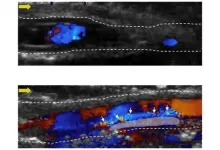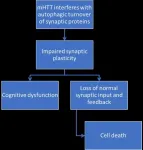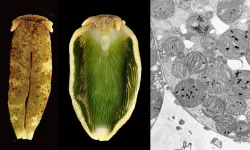(Press-News.org) Penn State College of Engineering researchers set out to develop technology capable of localizing and imaging blood clots in deep veins. Turns out their work may not only identify blood clots, but it may also be able to treat them.
The team, led by Scott Medina, assistant professor of biomedical engineering, published its results in Advance Healthcare Materials.
"Deep vein thrombosis is the formation of blood clots in deep veins, typically in a person's legs," said Medina. "It's a life-threatening blood clotting condition that, if left unaddressed, can cause deadly pulmonary embolisms -- when the clot travels to the lungs and blocks an artery. To manage DVT, and prevent these life-threating complications, it's critical to be able to rapidly detect, monitor and treat it."
The challenge, according to Medina, is that current diagnostic imaging methods lack the resolution required to precisely pinpoint potential breeding grounds for clots and monitor the clots in real time. DVT can sometimes present as swelling and aching in a person's leg, which can then be examined via ultrasound.
"Ultrasound isn't great for diagnosing DVT," Medina said. "It can tell you that a region of fluid flow may look odd, which might be related to a clot -- but maybe not. You follow up with blood tests to look for specific factors, and, together, you might be able to diagnose a clot."
Once a clot is diagnosed, a clinician may order either pharmaceuticals to help break it apart or a procedure that involves snaking a probe to the clot to grab it and physically remove it from the body. The pharmaceuticals may not be enough to break the clot apart, though, or they could trigger bleeding issues elsewhere in the body, while the procedure option is invasive and carries risks, including potential infection.
To better identify the location, composition and size of clots, which informs how to treat them, Medina and his team used a particle approach they developed in 2017. Called nanopeptisomes (NPeps), the particles comprise a shell around a droplet of fluorine-based oil similar to liquid Teflon. The surface of the shell holds a molecule that finds and binds a protein on the surface of activated platelets, a key cellular component of clots.
"The particles bind to the surface of the clots, we apply the ultrasound, and the droplet turns to gas and forms a bubble under the shell," said Medina. "It gives an excellent contrast for imaging. The bubbles appear exactly where the clots are forming."
But, Medina said, a mystery unfolded as they tested their technique. To analyze how to diagnose and treat clots, the researchers first induce clots in bovine veins by injecting an enzyme that triggers clot formation.
"The enzyme induces clot formation generally 100% of the time -- but when we applied the particles, we only saw clot formation about 30% of the time," Medina said. "We had to wonder: were the particles not only binding to the clots, but somehow breaking them down?"
The team tested its hypothesis, but the researchers would lose the bubble signal after 15 minutes of ultrasound every time.
"We think that once our particles start to decorate the clot, they saturate the surface and inhibit the mechanisms of further clot growth," said Medina. "And under the ultrasound, the particles are disrupting the clot or inhibiting its mechanism to persist. While we don't understand the underlying mechanism yet, it's clear that these particles can image and help treat clots in real time."
The researchers plan to continue investigating how the particles are disrupting the clots, as well as develop more control over how the particles behave.
INFORMATION:
Medina is also affiliated with the Materials Research Institute and the Huck Institutes of Life Sciences. Other contributors include Janna N. Sloand, Connor T. Watson, Michael A. Miller, Keefe B. Manning, all with the Department of Biomedical Engineering; Eric Rokni and Julianna C. Simon, both with the Graduate Program in Acoustics.
The National Science Foundation Faculty Early Career Development Program, a Penn State Multidisciplinary Seed Grant and a Penn State Graduate Research Fellowship supported this work in part.
The research seeks to understand what drives decisions in data analyses and the process through which academics test a hypothesis by comparing the analyses of different researchers who tested the same hypotheses on the same dataset. Analysts reported radically different analyses and dispersed empirical outcomes, including, in some cases, significant effects in opposite directions from each other. Decisions about variable operationalizations explained the lack of consistency in results beyond statistical choices (i.e., which analysis or covariates to use).
"Our findings illustrate the importance of analytical choices and how different statistical methods can lead to different conclusions," says Martin Schweinsberg. ...
Patients with advanced chronic kidney disease (CKD) typically suffer from impaired bone quality and quantity, with a non-vertebral fracture risk which is 4-to 6-fold higher than the fracture risk of matched controls. However, despite their high risk of fragility fractures, the vast majority of patients with chronic CKD stages 4 to 5D, are not receiving osteoporosis therapy.
A newly published review by the International Osteoporosis Foundation (IOF) and European Renal Association-European Dialysis and Transplant Association (ERA-EDTA) CKD-MBD working group now provides concise recommendations, with a clear management algorithm, to support clinicians' knowledge and confidence in managing ...
BOSTON - New research led by investigators at Massachusetts General Hospital (MGH) and Massachusetts Eye and Ear indicates that the blood pressure drug losartan may benefit patients with neurofibromatosis type 2 (NF2), a hereditary condition associated with vestibular schwannomas, or noncancerous tumors along the nerves in the brain that are involved with hearing and balance. The findings, which are published in Science Translational Medicine, are especially important because vestibular schwannomas are currently treated with surgery and radiation therapy (which carry risks of nerve damage), and no drug is approved by the U.S. Food and Drug Administration to treat these tumors or their associated hearing ...
Amsterdam, July 15, 2021 - Huntington's Disease (HD) is a progressive neurodegenerative condition characterized by motor, cognitive, and psychiatric symptoms, and motor symptoms are often preceded by cognitive changes. Recent evidence indicates that autophagy plays a central role in synaptic maintenance, and the disruption in autophagy may be at the root of these early cognitive changes. Understanding this mechanism better may help researchers develop treatments for patients with HD early in their disease progression, report scientists in a review article published in the Journal of Huntington's Disease.
In this review, experts describe how autophagy, the cellular process responsible ...
We sleep on average one third of our time. But what does the brain do during these long hours? Using an artificial intelligence approach capable of decoding brain activity during sleep, scientists at the University of Geneva (UNIGE), Switzerland, were able to glimpse what we think about when we are asleep. By combining functional magnetic resonance imaging (fMRI) and electroencephalography (EEG), the Geneva team provides unprecedented evidence that the work of sorting out the thousands of pieces of information processed during the day takes place during ...
The COVID-19 pandemic halted the in-person wintertime survey of wolves and moose on the island for the first time in 63 years. Consequently, there are no estimates of wolf or moose abundance for 2021, and the next estimates are scheduled in February 2022. But though the Isle Royale Winter Study didn't happen quite as planned, researchers were still able to visit the remote national park in the spring.
Now, fieldwork has resumed and Michigan Technological University researchers have already uncovered new information about these two iconic wildlife populations. In particular, wolves produced at least two litters of pups, and moose appear poised for decline.
In the Isle Royale Winter Study, Michigan ...
Plants, algae and some bacteria are able to perform photosynthesis, which is the process of transforming sunlight energy into sugar. Animals are generally unable to use this process to acquire energy, but there are a few known exceptions to this. Some sea slugs take up chloroplasts from the algae that they consume into their cells. These chloroplasts retain their ability to perform photosynthetic activity within the animal cells for several months, and thus provide them with photosynthesis-derived nutrition. This process is called "kleptoplasty", and it has attracted much attention due to its amazing uniqueness in making animals photosynthetic for over 50 years.
A pressing question is how these sequestered chloroplasts retains their photosynthetic capability without algal nuclei. ...
Since the Paris Climate Agreement that took effect in 2016, 121 countries have pledged to become carbon neutral by 2050 as the world tries to reduce its fuel consumption. The Korean government also unveiled its 2050 Carbon Neutral Strategy on December 7, 2020 and declared Carbon Zero, making transition to new and renewable energy a topic of conversation. Recently, a joint research team from POSTECH and Korea University has developed a radiative cooling material that can reduce energy consumption by selectively reflecting or transmitting sunlight.
A research team led by Professor Junsuk Rho, Ph.D. candidate Minkyung Kim, and Dr. Dasol Lee of POSTECH's departments of mechanical engineering and chemical engineering, and a team led by Professor Heon Lee and Soomin of the Department of Materials ...
Combined perceptions of the risk and availability of cannabis influence the risk of cannabis use more than perceived risk and perceived availability alone, according to a new study at Columbia University Mailman School of Public Health. Researchers observed that those who perceived cannabis as low-risk and available were more likely to report using the drug in the past year and almost daily compared to those individuals who perceived cannabis as high-risk and unavailable. This is the first study to consider the joint effects of perceived risk and perceived availability. The results are published in the journal Drug and Alcohol Dependence.
"Our study described the evolution of joint perceptions of cannabis risk and availability from 2002-2018 and estimated the relationship between combined ...
Adolescent girls and young women can and will use HIV prevention products with consistency, according to interim results of a study of two different methods: daily use of the antiretroviral (ARV) tablet Truvada® as oral pre-exposure prophylaxis (PrEP) and the monthly END ...




